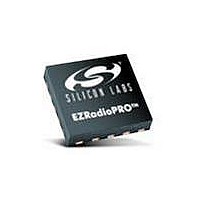4421-DKDB2 Silicon Laboratories Inc, 4421-DKDB2 Datasheet - Page 23

4421-DKDB2
Manufacturer Part Number
4421-DKDB2
Description
KIT DEV TEST EZRADIO SI4421 TRX
Manufacturer
Silicon Laboratories Inc
Specifications of 4421-DKDB2
Accessory Type
Test Card, Transceiver, 434MHz
Wireless Frequency
434 MHz
Interface Type
SPI
Modulation
FSK
For Use With/related Products
EZRadio®
Lead Free Status / RoHS Status
Lead free / RoHS Compliant
Lead Free Status / RoHS Status
Lead free / RoHS Compliant, Lead free / RoHS Compliant
There are four operation modes:
1. (a1=0, a0=0) Automatic operation of the AFC is off. Strobe bit can be controlled by the microcontroller.
2. (a1=0, a0=1) The circuit measures the frequency offset only once after power up. This way, extended TX-RX distance can be
achieved. In the final application, when the user inserts the battery, the circuit measures and compensates for the frequency offset
caused by the crystal tolerances. This method allows for the use of cheaper quartz in the application and provides protection against
tracking an interferer.
3. (a1=1, a0=0) The frequency offset is calculated automatically and the center frequency is corrected when the VDI is high. The
calculated value is dropped when the VDI goes low. To improve the efficiency of the AFC calculation two methods are recommended:
In both cases (3a and 3b), when the VDI indicates poor receiving conditions (VDI goes low), the output register is automatically
cleared. Use this “drop offset” mode when the receiver communicates with more than one transmitter.
4. (a1=1, a0=1) It is similar to mode 3, but suggested to use when a receiver operates with only one transmitter. After a complete
measuring cycle, the measured value is kept independently of the state of the VDI signal. When the receiver is paired with only one
transmitter, it is possible to use this “keep offset” mode. In this case, the DRSSI limit should be selected carefully to minimize the
range hysteresis.
11. TX Configuration Control Command
Bits 8-4 (mp, m3 to m0): FSK modulation parameters:
The resulting output frequency can be calculated as:
where:
Note:
Bits 2-0 (p2 to p0): Output power:
Note:
Bit
a. The transmit package should start with a low effective baud rate pattern (i.e.: 00110011) because it is easier to receive. The
circuit automatically measures the frequency offset during this initial pattern and changes the receiving frequency accordingly.
The further part of the package will be received by the corrected frequency settings.
b. The transmitter sends the first part of the packet with a step higher deviation than required during normal operation to ease
the receiving. After the frequency shift was corrected, the deviation can be reduced.
f
f 0 is the channel center frequency (see the
Frequency Setting Command)
M is the four bit binary number <m3 : m0>
SIGN = (mp) XOR FSK
For the optimal FSK modulation settings at different
data rates see the table on page 37.
The output power given in the table is relative to the
maximum available power, which depends on the
actual antenna impedance. (See: Antenna
Application Note: IA ISM-AN1)
15
p2
1
out
0
0
0
0
1
1
1
1
= f
p1
0
0
1
1
0
0
1
1
0
14
0
+ (-1)
p0
0
1
0
1
0
1
0
1
13
0
SIGN
Relative Output Power [dB]
· (M + 1) · (15 kHz)
12
1
11
1
-10
-12.5
-15
-17.5
10
-2.5
-5
-7.5
0
0
9
0
mp
8
m3
7
Note:
m2
6
m1
5
FSK represents the value of the actual data bit
P
out
m0
4
mp=0 and FSK=0
mp=1 and FSK=1
or
3
0
p2
2
df
fsk
p1
1
f
0
df
p0
0
fsk
mp=0 and FSK=1
mp=1 and FSK=0
9800h
or
POR
f
out
.
Si4421
23











